A big blue sky has been an elusive sighting this winter, but on a recent morning, Gary Morford and I caught one. Gary, the owner of Green Acre Farms in the Lower Valley, has graciously agreed to let me tag along in the pick-up for a few hours while he does his daily farm survey. Green Acre is a large farm with hops and fruit being the two biggest divisions, and mint, dill, wheat and carrot seeds being another division. After spending some time down at the main office on the Fort Road in Toppenish, an area surrounded by hops and hop processing equipment, we jump into his truck and are off to have a look at the various sites. Farms in winter are a unique thing. It’s true it is the off season, but don’t think that not much is going on. It’s more like a scene change. The curtain is down, but there is an awful lot going on behind it. Because this day in particular was such a blue-sky beauty, the curtain was pulled back a bit to let the light in and allow for a peek inside.
Driving down the road, Mount Adams is in full view. We’re heading west. He takes me by the original farm headquarters started by his grandfather out on Island Road and shows me the house he grew up in. Talk about rooted in the Valley. 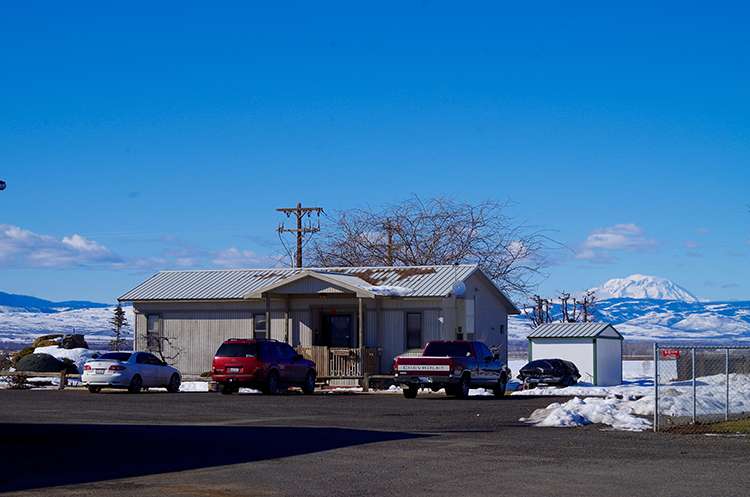 Mount Adams was practically a step-parent. Still an active farm site complete with a hop picking machine, Gary jumps out of the pick-up to touch base with one of the mechanics while I snap a picture or two. Then we’re back on the road.
Mount Adams was practically a step-parent. Still an active farm site complete with a hop picking machine, Gary jumps out of the pick-up to touch base with one of the mechanics while I snap a picture or two. Then we’re back on the road.
As we move still further west toward the ridge where the orchards are, the view of the hills is stunning. The little bit of melt we’ve had at this point has left a shine on the snowy prominent points giving them a fresh lacquered look which appears even more bright next to the sun facing dark areas where the snow is gone, leaving high gloss stripes. We head up the hill and arrive at the orchard office. Being on the ridge slope on such a clear day, the valley view opens up before us. There is much work being coordinated in this beautiful space. Tree removal, new orchard planning, and winter pruning are just a handful. As we walk over toward the shop Gary tells me there is a new hop picking machine being re-tooled and assembled for the main Fort Road site and I can see parts of it all over up here. Rather than being built from scratch, another machine from Idaho is being retro-fitted to work for Green Acres’ needs. I see as pieces are being cleaned and painted for their upcoming installation. On such a clear day, it’s a heck of an office view.
Back in the truck Gary and I zig-zag the orchard rows to the top perimeter. At the end of a road near orchard’s end, it’s evident that the unfarmed country is wild this far west up on the ridge, making the contrast between the clean lines of the fruit trees and the chaotic dots of twisted sage brush on the hillside seem more pronounced. To drive the point home, a wild horse stops to take a look at us from the sage side, not even trying to understand our need for order.
We work our way down the orcharded hillside. Of course, trees are everywhere. Some small and young, some larger and older. We even pass a few wine grapes mid-prune. Noticeable right away are the giant rows of the windbreak poplar trees that are being ripped out, their tall slender profiles coming down bits at a time. While beautiful, they are water hogs, and cast a bit too much shade on the sun loving fruit trees. 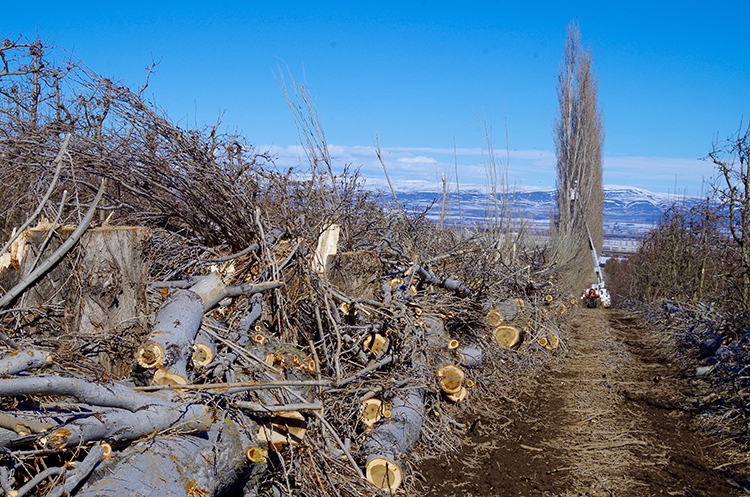 The ubiquitous clack of ladders can be heard as they are moved again and again for winter pruning, and there are still other areas where trees are pruned down to near the stump to prepare for grafting. There are also spots where entire blocks have been removed—the naked wind machines the only suggestion of the former trees. All orchards have a natural ebb and flow to them, where depending on the market trends, old varieties are taken out and new varieties are planted to sate consumer demands. Because it takes a few years before a new tree bears fruit, these new plantings have to be well thought out.
The ubiquitous clack of ladders can be heard as they are moved again and again for winter pruning, and there are still other areas where trees are pruned down to near the stump to prepare for grafting. There are also spots where entire blocks have been removed—the naked wind machines the only suggestion of the former trees. All orchards have a natural ebb and flow to them, where depending on the market trends, old varieties are taken out and new varieties are planted to sate consumer demands. Because it takes a few years before a new tree bears fruit, these new plantings have to be well thought out.
We enter a pear orchard where a fire blight scourge is being managed. On such a beautiful day, it seems criminal that the task at hand is to mitigate the risk presented by such a pathogen. Fire blight is a bacteria that affects apple and pear orchards. Branches wither and blacken and look as if they’ve been burned (hence the name). If it’s not controlled, whole orchards can be lost as it’s terribly contagious to other trees. Luckily, affected areas can be cut out. Winter is a great time to do it with the cold temperatures inactivating the bacteria. Because there is still snow on the ground, the blighted limbs have to be dragged to the row ends for pick up as the equipment can’t get into the rows. It’s all a muddy affair on a day like today. With sunshine comes melt, with melt comes mud. Luckily it’s just distracting and not debilitating. Gary checks in with the foreman, and things are moving along.
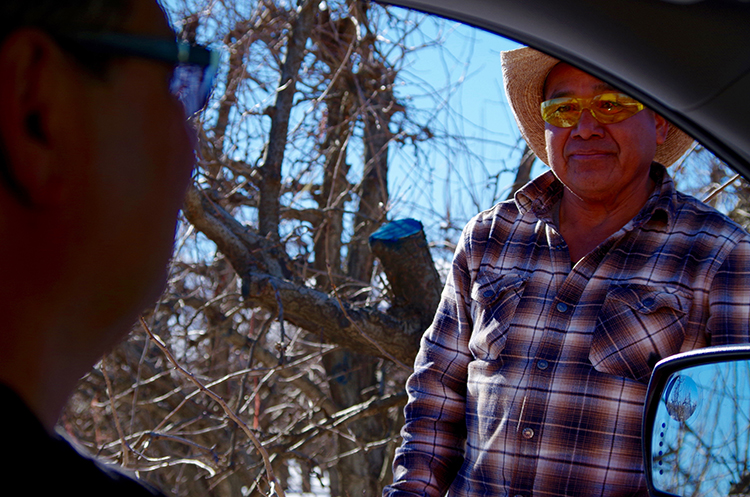
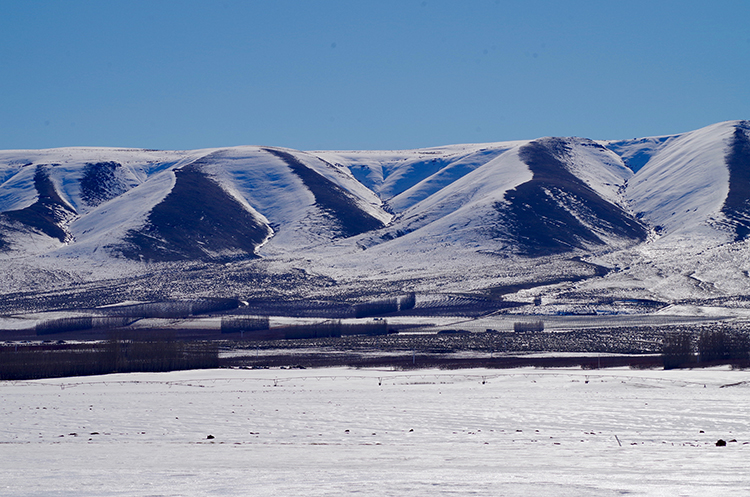 As we drive off the hill, we pass more hop fields and what will soon be mint when the snow abates, and other stretches that could be dill, carrots or wheat. These last three are rotated regularly depending on the demands of the soil. The new mint still he shows me is impressive, with six access points to hook tanks up for oil distillation (as I learned in the Cookin’ Mint story from last fall). We stop by another shop that serves this division, where more equipment is getting its winter work over. Shop doors open and music up, it’s game on—spring is both a welcome and anxiety provoking event. Welcome because it’s almost time to start farming, anxiety provoking because it’s almost time to start farming. Typically, when that start button is pushed everything needs to be ready to go.
As we drive off the hill, we pass more hop fields and what will soon be mint when the snow abates, and other stretches that could be dill, carrots or wheat. These last three are rotated regularly depending on the demands of the soil. The new mint still he shows me is impressive, with six access points to hook tanks up for oil distillation (as I learned in the Cookin’ Mint story from last fall). We stop by another shop that serves this division, where more equipment is getting its winter work over. Shop doors open and music up, it’s game on—spring is both a welcome and anxiety provoking event. Welcome because it’s almost time to start farming, anxiety provoking because it’s almost time to start farming. Typically, when that start button is pushed everything needs to be ready to go.
Gary explains as we drive that he works with some amazing folks. It’s this collaborative effort that makes all these different areas of farming work well, around and within each other. He feels very fortunate to have such amazingly skilled and knowledgeable people at Green Acre. Gary’s evident and palpable love for these people is his most defining character. It is the glue that keeps such a disparate farm together.
As we wrap up and make our way back over to the main office, we stop by one more hop picking area on Campbell Road. Walking over to yet another open door shop, Gary explains that here they are putting together miles of conveyor belts for the aforementioned new picking machine. Their work is impressive and the men are fiercely proud. More clean lines and structure, c-clamps and gear wheels. I think of that horse on the wild side of the orchard, indifferent to our desire for true angles. Seems like such an appropriate way to end my time here.
A huge thank you to Gary for being so generous with his time. It was truly a pleasure!
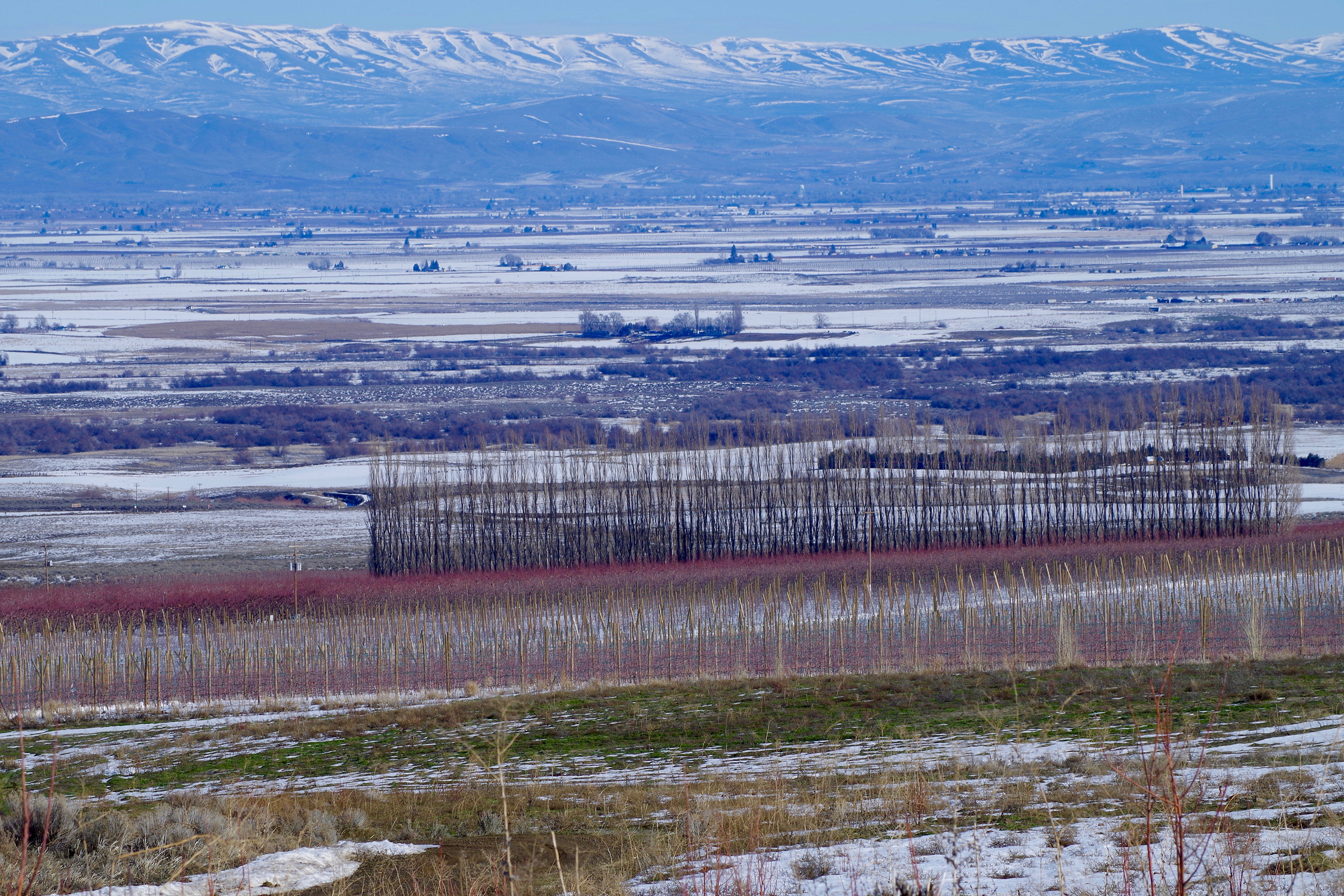





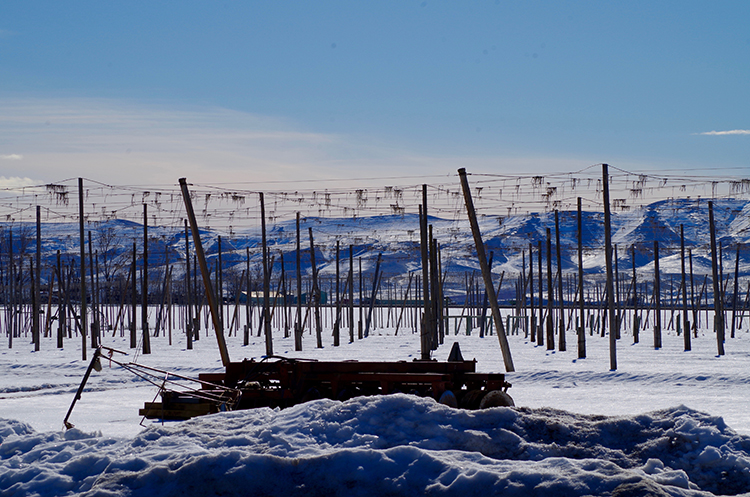
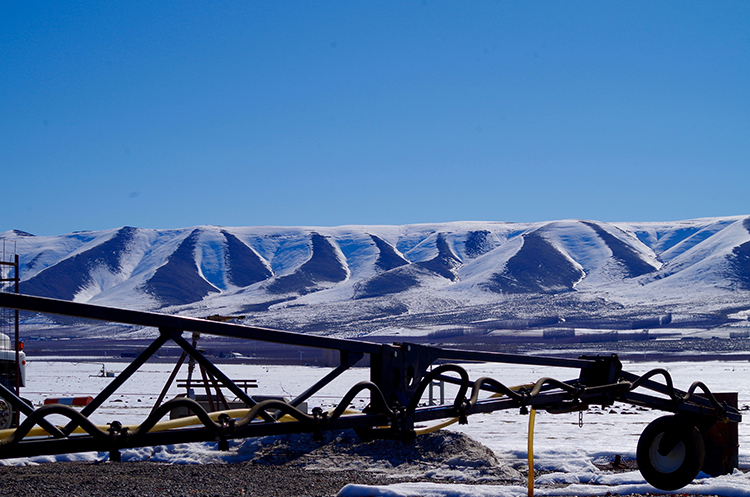

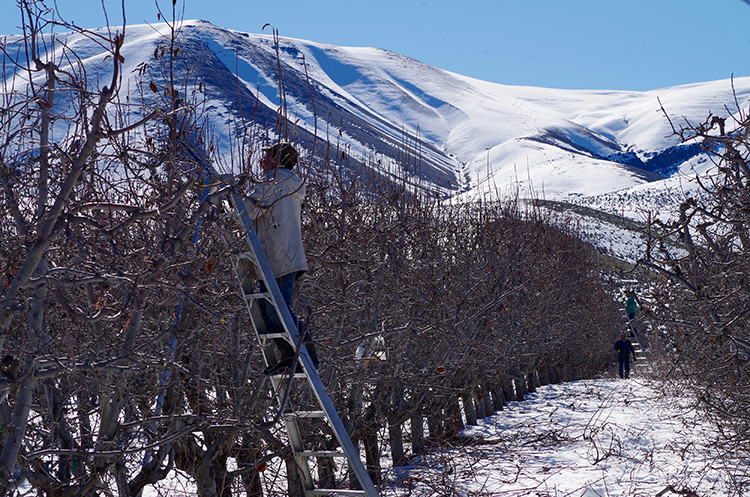
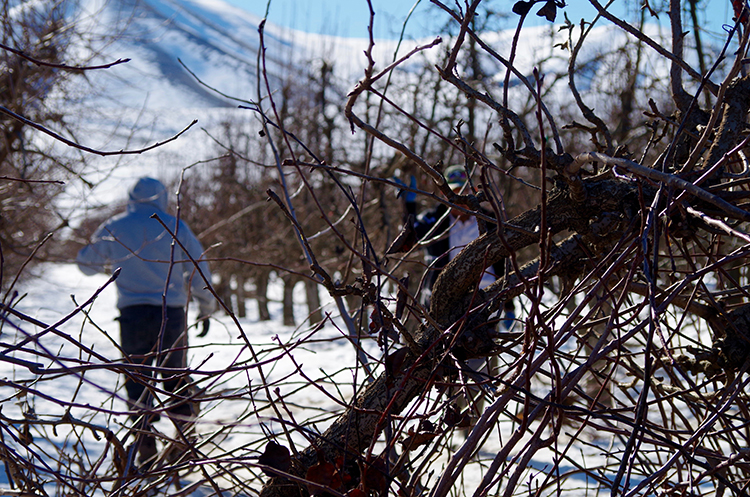
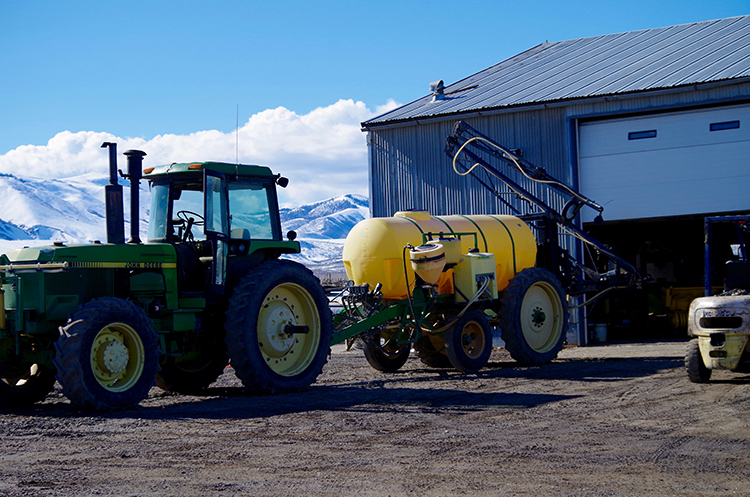

Terrific story /// beautiful photos.
Has Gary any perspective on how unusual the Valley snowfall
compares with prior decades. in the 46+ years I have been in the area , I don’t recall Toppenish ridge being spectacularly beautiful for such a prolonged interval. Is the am’t of precipitation responsible or the weeks of sub-zero weather that simply did not allow melt off between storms?
Does he or do you know the impact on the wild horse population? Prior to this winter, I noticed what appeared to be increased roundups and ” harvesting ” of horses.
Thanks for giving us a picture of Gary Morford that bring out the best. Of a individual, what a privilege to know the Parents of Gary as my wife Virgina used to baby set the kids! Blessing in a job will done.
I enjoy a view of the Yakima Valley through your meanderings here with Gary. It’s a world unknown to me, and so nice to get acquainted through the lens of your words and photos!